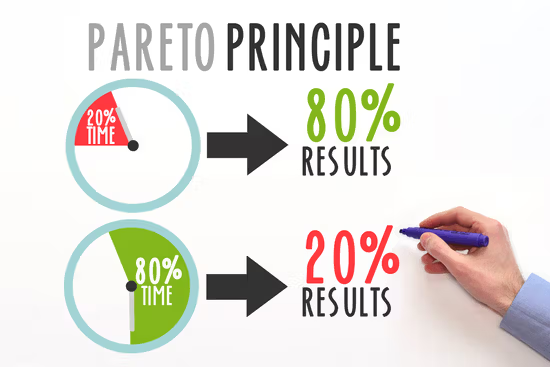

The 80/20 Rule, also known as the Pareto Principle, is a powerful concept that can revolutionize the way we approach time management and productivity. This principle suggests that roughly 80% of our results come from 20% of our efforts.
Let’s explore this topic in more detail with Ping Pong Go below to understand how we can harness the power of the 80/20 Rule to maximize our efficiency and achieve better outcomes in our personal and professional lives.
The 80/20 Rule, or Pareto Principle, was first observed by Italian economist Vilfredo Pareto in the late 19th century. He noticed that approximately 80% of the land in Italy was owned by 20% of the population. This observation led him to develop a mathematical formula that described the unequal distribution of wealth in society.
Over time, this principle has been applied to various fields, including business, economics, and personal productivity. The core idea is that a small number of causes often lead to a large number of effects. In the context of time management and productivity, this means that a small portion of our activities typically produces the majority of our results.
It’s important to note that the 80/20 ratio is not always exact; it’s more of a general guideline. The principle can manifest as 70/30, 90/10, or any other similar ratio. The key takeaway is that there’s often a significant imbalance between inputs and outputs.
Read more: How to Use the Pomodoro Technique to Stay Focused
When it comes to managing our time more effectively, the 80/20 Rule offers valuable insights. By identifying the 20% of our activities that yield 80% of our results, we can prioritize our efforts and focus on what truly matters. Here’s how you can apply this principle to your daily life and work:
Start by analyzing your daily tasks and responsibilities. Which activities contribute the most to your overall productivity and success? These are likely your “20%” tasks. They might include strategic planning, client meetings, creative work, or skill development. Once you’ve identified these high-impact activities, make them a priority in your schedule.
Conversely, identify the tasks that consume a lot of your time but produce minimal results. These are your “80%” activities that yield only 20% of your outcomes. While some of these tasks may be necessary, look for ways to streamline, delegate, or eliminate them where possible. This might involve automating repetitive tasks, outsourcing non-core activities, or simply saying “no” to low-priority requests.
The 80/20 Rule can also be applied to your skills and talents. Focus on developing and utilizing your strongest abilities, as these are likely to produce the best results. By concentrating on what you do best, you can maximize your productivity and achieve better outcomes in less time.
Now that we understand the principle, let’s explore practical ways to incorporate the 80/20 Rule into your daily work routine:
When creating your to-do list, rank your tasks based on their potential impact. Focus on completing the top 20% of tasks that will yield 80% of your desired results. This approach ensures that you’re always working on your most important and valuable activities.
Allocate specific time blocks for your high-impact tasks. These are the activities that require your full attention and energy. By dedicating uninterrupted time to these crucial tasks, you can maximize your productivity and achieve better results.
Inspired by the 80/20 Rule, the “One Thing” approach involves identifying the single most important task that will have the greatest impact on your goals. Start your day by focusing on this task before moving on to other responsibilities. This ensures that you’re always making progress on your most critical objectives.
Periodically review your activities and their outcomes. Are you spending your time on the right things? Are there new high-impact tasks that you should prioritize? Regular assessment allows you to stay aligned with the 80/20 principle and continuously improve your productivity.
While the 80/20 Rule is a powerful tool for time management, it’s important to address some common challenges and misconceptions:
Some people misinterpret the 80/20 Rule as an excuse to neglect the “80%” of tasks that produce lesser results. However, the principle doesn’t advocate for ignoring these tasks entirely. Instead, it encourages a more balanced approach, where you allocate your time and energy more efficiently.
One challenge in implementing the 80/20 Rule is distinguishing between urgent and important tasks. Urgent tasks often demand immediate attention but may not always be the most important in terms of long-term impact. Use tools like the Eisenhower Matrix to help differentiate between urgency and importance, allowing you to focus on high-impact activities.
Even when we identify our high-impact tasks, procrastination can still be a significant hurdle. To combat this, try breaking down your important tasks into smaller, more manageable steps. You can also use techniques like the Pomodoro Technique to maintain focus and momentum.
The 80/20 Rule can sometimes lead to a focus on short-term results at the expense of long-term objectives. It’s crucial to maintain a balance between immediate high-impact tasks and activities that contribute to your long-term success. Regularly reassess your goals and ensure that your prioritization aligns with both short-term and long-term objectives.
The 80/20 Rule doesn’t exist in isolation; it can be effectively combined with other productivity techniques to create a comprehensive time management strategy:
Use the Pomodoro Technique to maintain focus on your high-impact tasks. Work in focused 25-minute intervals, followed by short breaks. This method can help you maintain concentration and avoid burnout while tackling your most important activities.
David Allen’s GTD system complements the 80/20 Rule by providing a framework for organizing and managing tasks. Use GTD principles to capture, clarify, and organize your tasks, then apply the 80/20 Rule to prioritize and execute them effectively.
Combine the 80/20 Rule with the Eisenhower Matrix to further refine your task prioritization. This matrix helps you categorize tasks based on their urgency and importance, allowing you to focus on activities that align with the 80/20 principle.
Read more: Time Blocking vs. To-Do Lists: Which Boosts Productivity More?
In today’s digital age, various tools and applications can help you implement the 80/20 Rule more effectively:
Use time-tracking apps to monitor how you spend your time. This data can help you identify your most productive periods and the tasks that consume most of your time, allowing you to make informed decisions about prioritization.
Utilize project management tools to organize your tasks and collaborate with team members. Many of these tools allow you to categorize and prioritize tasks, making it easier to focus on high-impact activities.
Consider using productivity dashboards that provide an overview of your key performance indicators (KPIs) and most important tasks. These visual tools can help you stay focused on your high-impact activities and track your progress over time.
The Pareto Principle isn’t just for individual productivity; it can also be applied to team management and leadership:
In many cases, a small percentage of team members may be responsible for a large portion of the team’s output. Recognize and nurture these high performers, while also providing support and development opportunities for others to improve their productivity.